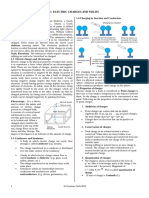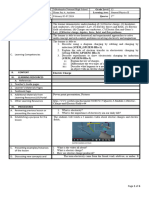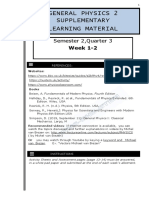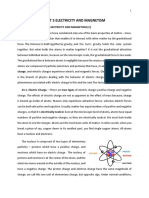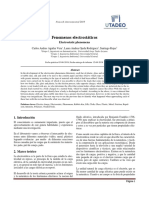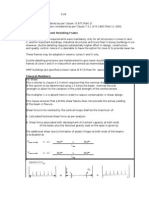Lab 1 Electrostatics: Charging Objects by Friction: Fig. 1.0.2 Fig. 1.0.1 Solar System Model (A.k.a
Lab 1 Electrostatics: Charging Objects by Friction: Fig. 1.0.2 Fig. 1.0.1 Solar System Model (A.k.a
Uploaded by
Angelus Vincent GuilalasCopyright:
Available Formats
Lab 1 Electrostatics: Charging Objects by Friction: Fig. 1.0.2 Fig. 1.0.1 Solar System Model (A.k.a
Lab 1 Electrostatics: Charging Objects by Friction: Fig. 1.0.2 Fig. 1.0.1 Solar System Model (A.k.a
Uploaded by
Angelus Vincent GuilalasOriginal Title
Copyright
Available Formats
Share this document
Did you find this document useful?
Is this content inappropriate?
Copyright:
Available Formats
Lab 1 Electrostatics: Charging Objects by Friction: Fig. 1.0.2 Fig. 1.0.1 Solar System Model (A.k.a
Lab 1 Electrostatics: Charging Objects by Friction: Fig. 1.0.2 Fig. 1.0.1 Solar System Model (A.k.a
Uploaded by
Angelus Vincent GuilalasCopyright:
Available Formats
Lab 1 – Electrostatics: Charging Objects by Friction 1
Name _________________________________ Date ____________________________
Lab 1
Electrostatics: Charging Objects by Friction
Overview
Static electricity is the result of an imbalance of charge in materials. Since all
materials are made up of atoms, it is important to understand how the positive and
negative charges in the atom produce this imbalance of charge in objects.
An atom encapsulates positive (protons), neutral (neutrons) and negative
(electrons) charges within it. The positive and neutral charges make up the core or nucleus
of the atom, while electrons carrying a negative charge surround the nucleus. A very crude
model of the atom likens it to the solar system, which is described below as the Solar
System Model in Fig. 1.0.1. A more accurate model, which we believe today, is the
Electron Cloud Model, described below in Fig. 1.0.2.
Fig. 1.0.1 Solar System Model (a.k.a
Rutherford’s Model of Atom) is the
most common way to picture an
atom. The model describes electrons
orbiting around the nucleus in a
fashion similar to planets orbiting the
Sun. Just like planets have their orbits
and are located at different distances
from the Sun, the electrons have their
own trajectory and distance from the
nucleus. This model is still popular in
teaching physics as it is easier to
visualize.
Fig. 1.0.2 The Electron Cloud Model
claims that there are no orbitals.
Instead, the electrons are located
around the nucleus within certain
boundaries or shells.
These shells are described as the most
probable locations for electrons to be
found. The boundaries are fuzzy and
the precise locations of the electrons
are unknown. This model, which is
based on probability, is considered
more advanced, and it is commonly
used in chemistry and quantum
mechanics.
University of Virginia Physics Department
Lab 1 – Electrostatics: Charging Objects by Friction 2
Name _________________________________ Date ____________________________
Typically, the number of electrons equals the number of protons. The outer
electrons are located farthest from nucleus and are held more loosely than the rest. On
contact between two materials, electrons may migrate from one material to another. This
migration will create an imbalance of charges. The object whose atoms lost electrons will
be left with a positive charge on it and the object that received or “captured” the electrons
will have a negative charge. This imbalance of charges is what creates static electricity.
Insulators and Conductors
Materials made of atoms that hold on to their electrons very tightly are called
insulators. Materials made of atoms that have a weak attraction to their electrons are
called conductors. If you take a segment of electric wire, you will have both types of
materials in it. The silicon that wraps around the metal is an insulator, and the metal
inside is a conductor. Electrons inside conductors are free to move as influenced by
various forces. They either move inside the conductor itself or can migrate to another
conductor.
Electrons inside insulators can only move within atoms themselves and cannot
move along the insulator. They may stretch the atoms or rotate them but never leave the
atoms under normal circumstances. Nevertheless, every insulator has a maximum electric
field strength that it can withstand without a breakdown. At the breakdown, the electric
field frees bound electrons, thus turning the insulator into a conductor. The breakdown
point depends on different factors, which include humidity, temperature, thickness of the
insulator, as well as the strength of the electric field.
The Triboelectric Series
Triboelectricity means electric charge generated by friction. It comes from the
Greek word “tribos”, which means rubbing. Historically, Benjamin Franklin named the
charge on glass positive and the charge on silk negative after he rubbed them against one
another. When an insulator like glass is rod rubbed against an insulator like silk, a charge
transfer occurs between the two materials. Silk attracts the loose electrons from the
surface of glass and becomes negatively charged. Because charge is conserved, the glass
rod is left positively charged. Transfer of electrons is responsible for charging; the
protons in atoms remain where they are.
Materials possess various tendencies to acquire or lose electrons; the ordering of
these tendencies is referred to as the triboelectric series. The list below orders a number
of common materials by their electrical nature. See Fig. 1.0.3. The tendency of a material
to acquire charge determines is place in the triboelectric series. The series is also called
the electronegativity scale. The chemical property of an atom to attract electrons itself is
called electronegativity. The top of the list measures the ability of the material to acquire
positive charge by giving up electrons while the bottom of the list is a measure of the
material to acquire negative charge or electrons. The further apart in the series the two
materials are, when rubbed together, the greater the charge acquired by each material. For
example, when Teflon is rubbed with silk, Teflon acquires a negative charge and silk
acquires a positive charge. Because they are quite far apart in the series, each acquires a
large amount of charge. Another example is when glass is rubbed with silk. The glass
acquires a positive charge and the silk now acquires a negative charge. Because silk and
glass are close together in the series, each acquires less charge and there is less charge
imbalance.
University of Virginia Physics Department
Lab 1 – Electrostatics: Charging Objects by Friction 3
Name _________________________________ Date ____________________________
Fig. 1.0.3 The triboelectric
series shows the relative
tendencies of objects to
gain positive or negative
charges when rubbed
against one another. For
example, if we rub glass
on silk, glass will gain
positive charge and silk
will gain negative charge.
Neutral and Polarized Objects
An object is said to be neutral if it contains the same number of positive and
negative charges. In Fig. 1.0.4 below the material is neutral since each atom contains the
same number of positive and negative charges. The arrangement of the charge in the
atom is such that the center of negative charge is on one side and the center of the
positive charge is on the other. Each atom is arranged randomly so that the orientation of
the charges is different throughout the material.
University of Virginia Physics Department
Lab 1 – Electrostatics: Charging Objects by Friction 4
Name _________________________________ Date ____________________________
INVESTIGATION 2: CHARGE POLARIZATION
An object is said to be neutral if it contains the same number of
positive and negative charges. A neutral object can, however,
produce some of the same phenomena as a charged object as a
result of a process known as polarization. We already know that
opposite charges attract. If we recall that charges are somewhat
free to move within an object, we should not be surprised that a
positively charged object will induce a charge alignment in a
neutral object so that the object’s electrons are as near to the
positively charged object as possible. As a result, the neutral
object will appear to react to an electric force as though it were
charged. When you charge by induction, you are exploiting
polarization by reorienting the Fig. 1.0.4
charges; mobile electrons move to
one side leaving positive ions on the other. This is one example of
polarization.
A neutral object can, however, produce some of the same phenomena as a
charged object as that
Recall a result of a process
in a conductor, known
electrons astopolarization.
are free We already know that
move. Polarization
in a conductor, then, is a result of a movement of
opposite charges attract. If we recall that charges are somewhat free electrons to one to move within an
side of an object. Electrons are not free to move in an insulator;
object, we should not be surprised that a positively charged object will induce a charge
this does not mean, however, that an insulator does not experience
alignment in polarization.
a neutral object so that
Polarization theinsulator
in an object’sis aelectrons are
result of an as near to the positively
alignment
charged object as possible. As a result, the neutral
of the charge within each individual molecule (Figure 5).object will appear to react to an
electric force as though it were charged. See Fig. 1.0.5.
Charged
object
Polarized insulator
Fig. 1.0.5
Figure 5
__________________________________________________________________________________
The
University of Virginia electrons
Physics Departmentand
nuclei
in
the
atoms
that
make
up
an
object
carry
equal
and
PHYS 6360opposite
charges,
so
the
whole
object
appears
neutral.
When
a
second,
charged
object
comes
close,
it
induces
the
electrons
to
align
themselves
slightly
away
from
the
nuclei.
This
process
is
known
as
polarization. For example, in Fig. 1.0.6 below, a
plastic comb (negatively charged) attracts pieces of paper (neutral) after combing through
hair.
University of Virginia Physics Department
Lab 1 – Electrostatics: Charging Objects by Friction 5
Name _________________________________ Date ____________________________
Fig. 1.0.6
Different Ways to Obtain Charge
There are primarily three different methods in how material gets charged. We call
them rubbing or friction, conduction or touching, and induction. The three methods are
illustrated below in Fig. 1.0.7. In Lab01 we will focus on charging by friction. More
details on the other two methods will be given in Lab02 and Lab03.
Fig. 1.0.7
University of Virginia Physics Department
Lab 1 – Electrostatics: Charging Objects by Friction 6
Name _________________________________ Date ____________________________
Activity 1 - 1: Charging Objects by Friction
Objective: Charge selected objects by rubbing them on silk; observe the effect of charge
on small objects around it.
Materials:
• Acrylic Rod*
• Teflon Rod
• Silk
• Scrap Paper (confetti)
* We use acrylic rods instead of traditional glass rods for safety reasons. Acrylic
ranks about the same as glass in the triboelectric series.
The materials except for the confetti are shown in Fig 1.1.1.
Fig. 1.1.1
University of Virginia Physics Department
Lab 1 – Electrostatics: Charging Objects by Friction 7
Name _________________________________ Date ____________________________
Procedure:
1. Cut a piece of dry, scrap paper into a few quarter-inch squares.
2. Neutralize the Teflon rod by sliding it slowly across your palm. Move the rod
towards the paper squares. Describe the behavior of the squares.
__________________________________________________________________
3. Rub the Teflon rod with silk. Move the rod towards the paper squares. Describe
the behavior of the squares. ___________________________________________
4. Repeat the same process with the acrylic rod. Describe the behavior of the squares
before and after the acrylic rod is charged. _______________________________
5. We have seen that paper spares are attracted to the rods when they are charged.
But it is unclear why that happens. We will revisit the phenomenon in activity 3.
Meanwhile, can we tell from the behavior of the paper squares alone whether the
charges on the acrylic rod and the Teflon rod have the same polarity after rubbing
against silk, or different? _____________________________________________
6. We will examine the charges on the acrylic rod and the Teflon rod again in the
next activity. What do you predict about the polarities of charges? Why?
__________________________________________________________________
University of Virginia Physics Department
Lab 1 – Electrostatics: Charging Objects by Friction 8
Name _________________________________ Date ____________________________
Activity 1 - 2: Electrical Forces between Charged Objects
Objective: Show that charged objects could attract or repel each other, depending on the
polarity of charges involved.
Materials:
• Acrylic Rod x2
• Teflon Rod x2
• Silk
• The Spinner*
* The “spinner” consists of two parts – the base and the cap. The base is a piece of
acrylic with a protruding metal pin. A cork is placed over the metal pin during
shipping and handling for safety reasons. Remove the cork only when the apparatus is
in use. The cap is another piece of acrylic that is designed to rotate freely on the metal
pin. See Fig. 1.2.1 and Fig. 1.2.2.
Fig. 1.2.1 Fig 1.2.2
Procedure:
1. Charge one end of the first Teflon rod by striking it on the silk cloth and place this
Teflon rod on the spinner. Now charge one end of the second Teflon rod.
Fig1.2.3
University of Virginia Physics Department
Lab 1 – Electrostatics: Charging Objects by Friction 9
Name _________________________________ Date ____________________________
Fig. 1.2.4
2. After charging both rods, hold one Teflon rod in your hand parallel to the Teflon
rod on the spinner as shown in Fig. 1.2.3 and Fig. 1.2.4 in order to ensure the
greatest possible interaction between the two. Record the direction of the force
(attract or repel) in Table 1.2.1.
3. Repeat the same process with two acrylic rods. Record the direction of the force
in Table 1.2.1.
4. Repeat the same process with one acrylic rod and one Teflon rod. Record the
direction of the force in Table 1.2.1.
Direction of Electrical Forces Between Charged Objects
Teflon (-) Acrylic (+)
Teflon (-)
Acrylic (+)
Table 1.2.1
5. What can we generalize about the direction of the electric force between charged
objects of the same kind, according to entries in the table above? If opposite
charges attract, then why does positive charge stay on silk and negative charge on
Teflon after we rub them against one another? ____________________________
University of Virginia Physics Department
Lab 1 – Electrostatics: Charging Objects by Friction 10
Name _________________________________ Date ____________________________
Activity 1 - 3: Forces between a Charged Object and an
Uncharged Object
Objective: Move a wooden rod on the spinner.
Materials:
• Acrylic Rod
• Teflon Rod
• Wooden Rod*
• Silk
• The Spinner
* The wooden rod likes to absorb moisture from the air and becomes slightly conductive.
In addition it is not so easily charged when rubbed. Thus, it is excluded from the previous
two activities.
Procedure:
1. Place the wooden rod in the slot on the spinner. Charge the Teflon rod by rubbing
it on silk.
.
2. Hold the Teflon rod in your hand parallel to the wooden rod on the spinner as
shown in Fig. 1.3.1 to ensure the greatest possible interaction. Record the
direction of the force in Table 1.3.1.
Fig. 1.3.1 A wooden rod is placed on the spinner. A Teflon rod is then charged and used
to rotate the wooden rod without touching it. Note the direction of the electric force
between the two.
3. Substitute the Teflon rod with the acrylic rod. Repeat the same process. Record
the direction of the force in Table 1.3.1.
4. Recall the description about how paper squares behave near charged acrylic and
Teflon rods in Activity 1. If you are not sure, redo activity 1 to double check. Fill
in Table 1.3.1.
University of Virginia Physics Department
Lab 1 – Electrostatics: Charging Objects by Friction 11
Name _________________________________ Date ____________________________
Direction of Electrical Forces between a Charged Object and an Uncharged Object
Teflon (-) Acrylic (+)
Wood (0)
Paper (0)
Table 1.3.1
5. What can we generalize about the direction of the electric force between a
charged object and an uncharged object? ________________________________
University of Virginia Physics Department
Lab 1 – Electrostatics: Charging Objects by Friction 12
Name _________________________________ Date ____________________________
Activity 1- 4: Sneaky Static
Objective: Raise awareness of static electricity in everyday life.
Materials:
• Scotch tape
• Teflon rod
• Silk
Procedure:
1. Pull 4 segments of scotch tape of 5 cm each. Stick them on the edge of a table. As
shown in Fig. 1.4.1. Fold back 1cm on each segment to make a handle. Label
them A, B, C, and D.
Fig. 1.4.1
2. Stick the sticky side of A against the unsticky side of B together. Then pull them
apart. When you move them close to each other again, what do you observe about
the force between them? _____________________________________________
University of Virginia Physics Department
Lab 1 – Electrostatics: Charging Objects by Friction 13
Name _________________________________ Date ____________________________
3. Stick A and B on the edge of the table, using 1cm of the remaining sticky part
near the handle. About 2 cm of each segment should suspend over the edge of the
table and remain untouched.
4. Repeat steps 2 and 3 with C and D. What do you observe about the force between
them? ____________________________________________________________
5. Now pull A and C off the table. Move them close to each other. What do you
observe about the force between them? __________________________________
6. Put C back down and pick up D. Move A and D close to each other. What do you
observe about the force between them? __________________________________
7. Put A back down and pick up B. Before you move B and D close to each other,
what is your prediction about the force between them? What is the actual result?
__________________________________________________________________
8. Finally, charge up a Teflon rod with silk and use it to check the polarity of charge
on each segment by observing whether it attracts or repels the segment. What is
the polarity of charge on each segment? _________________________________
9. Static electricity can be sneaky in everyday life. List 3 household phenomena that
involve static electricity. _____________________________________________
University of Virginia Physics Department
You might also like
- Topic 1 Electric Charges and ForcesDocument15 pagesTopic 1 Electric Charges and ForcesSmk Abdul Rahim DuaNo ratings yet
- GP2 Q3W1Document24 pagesGP2 Q3W1DonggadongNo ratings yet
- Faculty of Civil Engineering and Architecture: Kaunas University of TechnologyDocument8 pagesFaculty of Civil Engineering and Architecture: Kaunas University of TechnologyDar MudasirNo ratings yet
- Physics II UD Chapter 1Document74 pagesPhysics II UD Chapter 1Lionel MedNo ratings yet
- Static Electricity: Lesson 1 - Basic Terminology & ConceptsDocument77 pagesStatic Electricity: Lesson 1 - Basic Terminology & ConceptsDERRICKKEANNo ratings yet
- Electric FieldDocument31 pagesElectric FieldMergen BahtyyarowNo ratings yet
- Reviewer in PhysicsDocument3 pagesReviewer in PhysicsBeatrice MararacNo ratings yet
- Science 7 - Module 7 - Version 3Document16 pagesScience 7 - Module 7 - Version 3Michelle Rose EntiaNo ratings yet
- SLK G7 Q3wk8 Mongcopa RevisedDocument11 pagesSLK G7 Q3wk8 Mongcopa RevisedTabada NickyNo ratings yet
- Class 12 Physics Ncert Textbook (Rationalised 2023-24)Document359 pagesClass 12 Physics Ncert Textbook (Rationalised 2023-24)rajvanshiaditya549No ratings yet
- Leph 101Document44 pagesLeph 101uwzennrheemlpro.comNo ratings yet
- RM 1 - ElectrostaticsDocument4 pagesRM 1 - Electrostaticsibdeveterbo.nhcsNo ratings yet
- General Physics 2Document20 pagesGeneral Physics 2christine isabel mendozaNo ratings yet
- Physics Grade 10 - Unit 3Document6 pagesPhysics Grade 10 - Unit 3philmonberhane2No ratings yet
- Physics NotesDocument7 pagesPhysics NotesSoe ThiriNo ratings yet
- MODULE 1 Electric Charge and Coulombs LawDocument12 pagesMODULE 1 Electric Charge and Coulombs LawVenus CaringalNo ratings yet
- Leph 101Document44 pagesLeph 101nelsonzakayo282No ratings yet
- Chapter One ELECTRIC CHARGES AND FIELDS 1Document25 pagesChapter One ELECTRIC CHARGES AND FIELDS 1anirvanishereNo ratings yet
- Charging Processes-G7Document20 pagesCharging Processes-G7hmoncatar.bulNo ratings yet
- Electrostatics - Direct Current PDFDocument76 pagesElectrostatics - Direct Current PDFRita UmutoniNo ratings yet
- 1E6 Electrical Engineering DC Circuit Analysis Lecture 1: The Nature of ElectricityDocument10 pages1E6 Electrical Engineering DC Circuit Analysis Lecture 1: The Nature of ElectricityEvita YatiNo ratings yet
- Electric Charges and Fields 19 July 2022Document6 pagesElectric Charges and Fields 19 July 2022Rajesh KodurNo ratings yet
- S.3 PHYSICS NOTES. TOPIC ELECTROSTATIcs 3Document9 pagesS.3 PHYSICS NOTES. TOPIC ELECTROSTATIcs 3bonglavjemason9No ratings yet
- General-Physics-2 Q3 M1 Electric-ChargeDocument8 pagesGeneral-Physics-2 Q3 M1 Electric-ChargeArian Avner De GuzmanNo ratings yet
- Electric ChargeDocument6 pagesElectric ChargeDiana Joy Ancheta CldheiNo ratings yet
- Leph 101Document44 pagesLeph 101Ravi AgrawalNo ratings yet
- Q3 M1 Electric ChargeDocument6 pagesQ3 M1 Electric ChargeShielami SarapuddinNo ratings yet
- SemiconductorDocument6 pagesSemiconductordksingh369No ratings yet
- Worktext in Electromagnetism For Teachers 1 Physics 1Document10 pagesWorktext in Electromagnetism For Teachers 1 Physics 1Alice C. RiveraNo ratings yet
- Experiment 13: ElectrostaticsDocument6 pagesExperiment 13: ElectrostaticsZhie Lou0% (1)
- Physics ProjectDocument44 pagesPhysics ProjectAvnish TewariNo ratings yet
- Charging by ConductionDocument7 pagesCharging by Conductionimanuelsukarno0% (1)
- Q3 GenPhys 2 Week 1-2Document14 pagesQ3 GenPhys 2 Week 1-2R Jay GubatangaNo ratings yet
- 1.7 Periodic Trends StudentDocument7 pages1.7 Periodic Trends StudentSALMA HELALNo ratings yet
- Unit 7 NotesDocument18 pagesUnit 7 Notesyooh9814No ratings yet
- Chapter 0 - 10 Electric ChargeDocument4 pagesChapter 0 - 10 Electric ChargeshengNo ratings yet
- Physics 2 Lesson 1Document4 pagesPhysics 2 Lesson 1Christel Anjie SevillaNo ratings yet
- Chapter 1 - Electric Charges and FieldsDocument16 pagesChapter 1 - Electric Charges and FieldsAnil SarohaNo ratings yet
- Basic Concepts in Electronics ServicingDocument13 pagesBasic Concepts in Electronics ServicingBenjamin FalletNo ratings yet
- Electrostatics CH1 Part - 1Document24 pagesElectrostatics CH1 Part - 1Rishab SharmaNo ratings yet
- Electric Charge and Electric FieldDocument3 pagesElectric Charge and Electric FieldAhmet UlusoyNo ratings yet
- B.SC - Physics Complete Notes of Electricity and MagnetismDocument134 pagesB.SC - Physics Complete Notes of Electricity and Magnetismizza ghafoorNo ratings yet
- Topic 2 Electric CircuitsDocument54 pagesTopic 2 Electric CircuitsMaan PatelNo ratings yet
- Electric Charges and FieldDocument19 pagesElectric Charges and Fieldshreyaschandrakanth007No ratings yet
- Electricity and Coulomb's LawDocument5 pagesElectricity and Coulomb's LawqajbcalaguiNo ratings yet
- Engg Physics - End Sem - Unit 4 - Q ADocument14 pagesEngg Physics - End Sem - Unit 4 - Q ADevansh ChoudhuryNo ratings yet
- Thorn Lighting Electrical TheoryDocument60 pagesThorn Lighting Electrical TheoryRahul MishraNo ratings yet
- AP Physc em Electric Charge Field Presentation 2018-08-13Document138 pagesAP Physc em Electric Charge Field Presentation 2018-08-13Evans QuayeNo ratings yet
- Module 1 Lesson 1Document9 pagesModule 1 Lesson 1judy ann naluzNo ratings yet
- Methods of ChargingDocument5 pagesMethods of Chargingjackkingsman19No ratings yet
- Unit 5 Electricity and MagnetismDocument7 pagesUnit 5 Electricity and MagnetismareejNo ratings yet
- General Physics 2 Module 1 PDF FreeDocument8 pagesGeneral Physics 2 Module 1 PDF FreesacherybebeNo ratings yet
- Atomic StructureDocument19 pagesAtomic StructureElmarNo ratings yet
- MTE 312 Electromagnetic Theory-1Document30 pagesMTE 312 Electromagnetic Theory-1skidaddy504No ratings yet
- Module 1 Basic Electrical Ideas and UnitsDocument12 pagesModule 1 Basic Electrical Ideas and Unitsnicole tumampilNo ratings yet
- CS-4 Module 1Document10 pagesCS-4 Module 1adrianniel.garigNo ratings yet
- Notes - Phy U4Document15 pagesNotes - Phy U4Aniket AgvaneNo ratings yet
- Laboratorio I Fisica 2Document9 pagesLaboratorio I Fisica 2Carlos AguilarNo ratings yet
- 1.electric Charges and FieldsDocument23 pages1.electric Charges and FieldsThomas WatsonNo ratings yet
- 10-15 Minutes: Learning Activity 1 LO1 Classify A Good or Bad Identifier/variableDocument1 page10-15 Minutes: Learning Activity 1 LO1 Classify A Good or Bad Identifier/variableAngelus Vincent GuilalasNo ratings yet
- Programming Logic and Design: Seventh EditionDocument38 pagesProgramming Logic and Design: Seventh EditionAngelus Vincent GuilalasNo ratings yet
- Programming Logic and Design: Seventh EditionDocument44 pagesProgramming Logic and Design: Seventh EditionAngelus Vincent GuilalasNo ratings yet
- Programming Logic and Design: Seventh EditionDocument32 pagesProgramming Logic and Design: Seventh EditionAngelus Vincent GuilalasNo ratings yet
- Programming Logic and Design: Seventh EditionDocument45 pagesProgramming Logic and Design: Seventh EditionAngelus Vincent GuilalasNo ratings yet
- ch1Document23 pagesch1Angelus Vincent GuilalasNo ratings yet
- UE3003 Instruction ManualDocument8 pagesUE3003 Instruction ManualAngelus Vincent Guilalas100% (1)
- Module 5 - L3: Routh Stability CriterionDocument19 pagesModule 5 - L3: Routh Stability CriterionAngelus Vincent GuilalasNo ratings yet
- Block Diagram and Signal Flow GraphDocument15 pagesBlock Diagram and Signal Flow GraphAngelus Vincent GuilalasNo ratings yet
- Quiz Bowl Mechanics General Guidelines ICpEPDocument3 pagesQuiz Bowl Mechanics General Guidelines ICpEPAngelus Vincent Guilalas100% (1)
- Control System Applied Principles of ControlDocument23 pagesControl System Applied Principles of ControlAngelus Vincent GuilalasNo ratings yet
- EXER2Document12 pagesEXER2Angelus Vincent GuilalasNo ratings yet
- Activity No 6Document5 pagesActivity No 6Angelus Vincent GuilalasNo ratings yet
- Week One Life Class ReadingsDocument1 pageWeek One Life Class ReadingsAngelus Vincent GuilalasNo ratings yet
- Activity No 1Document1 pageActivity No 1Angelus Vincent GuilalasNo ratings yet
- Determinate and Indeterminate Structures - FilesDocument8 pagesDeterminate and Indeterminate Structures - FilesSuvajit BisaiNo ratings yet
- Time Varying Fields and Maxwell'S EquationDocument23 pagesTime Varying Fields and Maxwell'S Equationnafisaah tartilaNo ratings yet
- Bridge Preliminary Seismic DesignDocument9 pagesBridge Preliminary Seismic Design6ylinder100% (1)
- Notes Form 2 7.3 MagnetismDocument2 pagesNotes Form 2 7.3 MagnetismChua Xiao Xuan100% (1)
- Buckling of MicropilesDocument4 pagesBuckling of MicropilesAnonymous qTP5oq7g100% (2)
- g90g20g77 Turning CycleDocument8 pagesg90g20g77 Turning CycleTatiana OlegovnaNo ratings yet
- Mos PPT (Ame004) (18 19 16)Document95 pagesMos PPT (Ame004) (18 19 16)Muhammad Rizwan QureshiNo ratings yet
- Asynchronous Operationand ResynchronizationDocument15 pagesAsynchronous Operationand Resynchronizationquangspkt0% (1)
- 2a-Dynamics MC Practice ProblemsDocument26 pages2a-Dynamics MC Practice Problemsruuki25No ratings yet
- NSCP Timber Beam DesignDocument27 pagesNSCP Timber Beam DesignDiztrict GarageNo ratings yet
- 1M32Document11 pages1M32Neill TeodoroNo ratings yet
- Heat Transfer: Conduction 1Document56 pagesHeat Transfer: Conduction 1S. Manash DixitNo ratings yet
- Ch.3 Linear Motion (Daily Test) 2Document3 pagesCh.3 Linear Motion (Daily Test) 2TreeiciclesNo ratings yet
- LECTURE 30 and 31: Deflection of BeamsDocument14 pagesLECTURE 30 and 31: Deflection of BeamskishorechakravarthyNo ratings yet
- 1.AEP Intro PDFDocument108 pages1.AEP Intro PDFanon_999896239No ratings yet
- Heat Transfer Chapter 2 Lecture SlidesDocument48 pagesHeat Transfer Chapter 2 Lecture SlidesMohammad TahirNo ratings yet
- Thermal and Power Plant EngineeringDocument47 pagesThermal and Power Plant EngineeringChaitanya Kishore ChitikenaNo ratings yet
- Helicopter Flight Dynamics: Rotor Flapping MotionDocument28 pagesHelicopter Flight Dynamics: Rotor Flapping MotionAlexandreSidant100% (1)
- CE-301 Solid MechanicsDocument1 pageCE-301 Solid MechanicsAyan GhoshNo ratings yet
- Soil Mechanics Ii CE 3509: Bearing CapacityDocument73 pagesSoil Mechanics Ii CE 3509: Bearing Capacityselda durmazNo ratings yet
- Modeling of Electromechanical SystemsDocument30 pagesModeling of Electromechanical Systemssm-malik100% (1)
- RC14 1334 Concrete+Structures+1 Lecture+21Document18 pagesRC14 1334 Concrete+Structures+1 Lecture+21'Riky Dwi Prasetyo'No ratings yet
- Motion and Vectors ExamDocument9 pagesMotion and Vectors ExamClaudia PinnaNo ratings yet
- MetII PDFDocument8 pagesMetII PDFMadara SantosNo ratings yet
- Manifold Flow in Pressure-Distribution SystemsDocument7 pagesManifold Flow in Pressure-Distribution Systems305773253No ratings yet
- Is 13920Document183 pagesIs 13920p_ignatiusNo ratings yet
- VD Chap - Road LoadsDocument41 pagesVD Chap - Road LoadsbmdbmdbmdNo ratings yet
- FM Online-Qb2 PDFDocument586 pagesFM Online-Qb2 PDFBharath m.s.v.mNo ratings yet
- Civil: Department: Semester: V Sub - Code/ Name: / Strength of MaterialsDocument55 pagesCivil: Department: Semester: V Sub - Code/ Name: / Strength of MaterialsMakesh KrishnaNo ratings yet
- Heat Transfer and The Energy EquationDocument28 pagesHeat Transfer and The Energy EquationAlejandroAguilarNo ratings yet





















